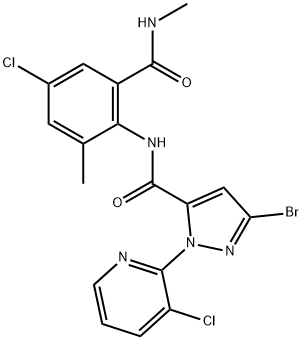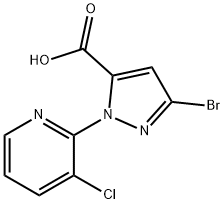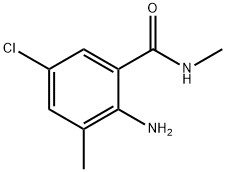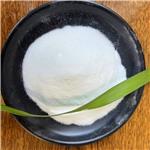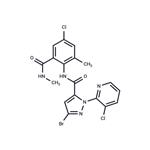Description
Chlorantraniliprole (Rynaxpyr) is an insecticide of the ryanoid class. It is a new compound by DuPont belonging to a new class of selective insecticides (anthranilic diamides) featuring a novel mode of action (group 28 in the IRAC classification). It is the first anthranilic diamide registered for use on turfgrass and landscape ornamentals. It is used to control a broad spectrum of pests including cabbage loopers, corn borers, Colorado potato beetle, European grapevine moth, armyworms and cutwormson a range of crops including potatoes and cotton. Its mechanism of action is through activating the insect ryanodine receptors (RyRs), further stimulating the release and depletion of intracellular calcium stores from the sarcoplasmic reticulum of muscle cells, causing impaired muscle regulation, paralysis and ultimately death of sensitive species.
Description
Chlorantraniliprole is an anthranilic diamide insecticide and agonist of ryanodine receptors located on the sarcoplasmic reticulum in muscle and endoplasmic reticulum in non-muscle cells. It binds to a different site than ryanodine on the receptor and stimulates the release of calcium from intracellular stores with EC
50 values ranging from 40 to 50 nM for
P. americana neurons and
H. virescens or
D. melanogaster recombinant ryanodine receptors. It is highly selective for insect over mammalian ryanodine receptors (EC
50s = 14,000 nM, >100 μM, and >100 μM for C2C12 mouse, PC12 rat, and IMR32 human cells, respectively). Chlorantraniliprole is active against insects of the order Lepidoptera, including larvae of the fall armyworm (
S. frugiperda), diamondback moth (
P. xylostella), and tobacco budworm (
H. virescens) with EC
50 values of 0.02, 0.01, and 0.05 ppm, respectively, and of the orders Coleoptera, Diptera, and Isoptera. Formulations containing chlorantraniliprole have been used in agriculture to control moths, beetles, and caterpillars among other insects.
Chemical Properties
White crystal, specific gravity (for liquid) 1.507g/mL, melting point 208-210℃, decomposition temperature 330℃, vapor pressure (under 20~25) 6.3×1012Pa, solubility (under 20~25, mg/L): water 1.023, acetone 3.446, methanol 1.714, acetonitrile 0.711, ethyl acetate 1.144. Chlorfenvinphos It is highly efficient and broad-spectrum, and has good control effect on Lepidoptera of Noctuidae, stem borer moths, fruit moths, leaf roller moths, pink moths, vegetable moths, wheat moths, and fine moths, etc. It can also control Sphingidae weevils, leaf beetles; Diptera subterranean flies; sooty fly and many other non-lepidopteran pests.
Uses
Chlorantraniliprole is a pyrazolylpyridine insecticide and an activator of insect ryanodine receptor. Used in Pesticide detection. (Solution)
Definition
ChEBI: Chlorantraniliprole is a carboxamide resulting from the formal condensation of the carboxylic acid group of 3-bromo-1-(3-chloropyridin-2-yl)-1H-pyrazole-5-carboxylic acid with the primary amino group of 2-amino-5-chloro-N,3-dimethylbenzamide. The first of the anthranilic diamide insecticides, it is a ryanodine receptor activator and is used to protect a wide variety of crops, including corn, cotton, grapes, rice and potatoes. It has a role as a ryanodine receptor agonist. It is an organobromine compound, a member of pyridines, a member of pyrazoles, a pyrazole insecticide, a member of monochlorobenzenes and a secondary carboxamide.
Preparation
Chlorantraniliprole was synthesized by reaction of 3-bromo-1-(3-chloropyridin-2-pyridinyl)-1H-pyrazole-5carboxylic acid with 2-amino-5-chloro-3-methylbenzoic acid.3-bromo-1-(3-chloropyridin-2-pyridinyl)-1H-pyrazole5-carboxylic acid was prepared by reaction of maleic anhydride with 2,3-dichloropyridine as starting materials in eight steps.2-Amino-5-chloro-3-methylbenzoic acid was prepared by reaction of 2-amino-3-methylbenzoic acid in one step.The structure of target compound was conf irmed by 1H NMR.Total yield was 36.3%(calculated with 2,3-dichloropyridine),and purity determined by HPLC was over 95%.
